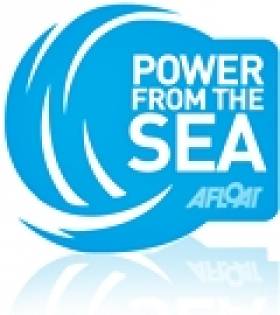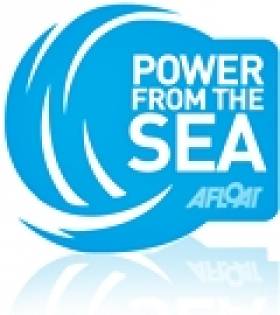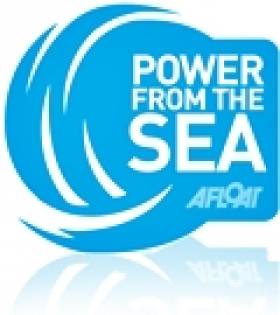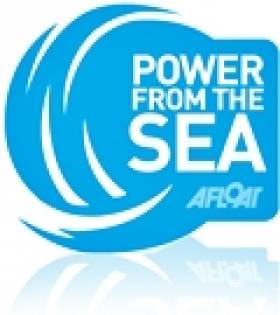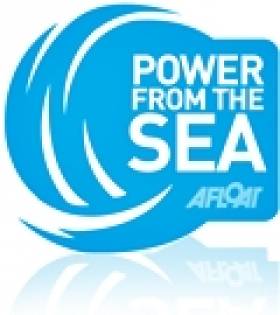Displaying items by tag: Power from the Sea
#NewDesign - A new catamaran designed for servicing offshore drilling and energy platforms could help work crews get to where they're needed safety in some of the roughest seas.
Wired's Autopia blog reports on the SHC Wavedancer, a proposed catamaran with a submersible hull that could literally cut through and dissipate potentially dangerous waves - keeping the vessel stable enough in swells of up to 15 feet so that delicate operations, such as work on oil pipelines or wind turbines, can proceed without delay.
The new design is the work of veteran energy installation and construction consultant Dennis Knox, who is looking to crowdfunding to finance the first stages of the project.
Wired Autopia has more on the story HERE.
£50m Offshore Wind Terminal Completed in Belfast Harbour
#BelfastWindTerminal - A new £50m offshore wind terminal which has been completed in Belfast Harbour, has been handed over to DONG Energy and ScottishPower Renewables.
As previously reported on Afloat.ie, the terminal, the first purpose-built offshore wind installation and pre-assembly harbour in the UK or Ireland, will be used as a hub to help service a market valued in excess of 100bn. Up to 300 jobs are expected to be created, ranging from welders to electricians and engineers.
The official hand-over was attended by Northern Ireland's First and Deputy First Ministers, Peter Robinson MLA and Martin McGuinness MLA, along with Len O Hagan, Belfast Harbour's Chairman and Brent Cheshire, DONG Energys UK Country Chairman.
DONG Energy has signed a lease for the terminal which will be used initially to support the development of the West of Duddon Sands Wind farm in the Irish Sea, a joint venture between ScottishPower Renewables and DONG Energy. Work on the wind farm has already started and Belfast Harbour has received its first shipment of wind farm components. Its anticipated that the first turbines will depart Belfast this summer for erection at the site.
Welcoming the handover, Len OHagan, Belfast Harbour's Chairman, said: "Delivering this immense project on time and on budget has been a major achievement. This is a historic development for Belfast which has the potential to usher in a major new industry for Northern Ireland a development which is all the more poignant given that this is the Harbours 400th anniversary year".
He added "Over the years the harbour has helped bring other industries to Belfast such as shipbuilding and aerospace by investing heavily in infrastructure and land reclamation. This is a continuation of that strategy and a demonstration of our long-term commitment to enhance the local economy".
The 50-acre terminal, located on the Co. Down side of the port, is the largest single investment in Belfast Harbours 400-year history. Built by local construction company Farrans, the project took 15-months, 750,000 man hours, one million tonnes of stones and 30,000 tonnes of concrete to complete.
The 200,000 m2 facility, large enough to accommodate 30 football pitches, includes a 480m deep-water quayside. Up to three vessels will be able to berth simultaneously with access available around the clock.
Brent Cheshire, DONG Energys UK Country Chairman commented: "Having a bespoke facility at our fingertips will help us plan our offshore construction very effectively and help with our work to lower the cost of offshore wind farms. The site is in an excellent strategic position for DONG Energy as we have several wind farms under development in the Irish Sea. This is a port that can handle the large number of huge pieces of equipment required".
Keith Anderson, ScottishPower Renewables CEO, added: "The facility at Belfast Harbour is one of the most advanced anywhere in the world for the assembly of offshore wind turbines, and we are delighted to be taking over the lease as we start offshore construction on the West of Duddon Sands project.
This marks a significant milestone for the West of Duddon Sands project, and we are sure that Belfast will play a hugely important role in its successful delivery. The investment in Belfast Harbour will ensure that the city has a long-term future as a leader in renewable energy.
Over 100 turbines, each with a rotor diameter of 120m, will be shipped from the new terminal to the West of Duddon Sands project. It will be one of the worlds largest offshore wind farms when it is commissioned in 2014.
The UK is Europes leading offshore wind generator and has plans to develop 11,000 new offshore wind turbines, a quarter of which are expected to be built within 150 nautical miles of Belfast. It is anticipated that 32 gigawatts of electricity, one quarter of the nations electricity needs, will be provided by offshore wind.
French Naval Defence Giant to invest €130m in OpenHydro
#OpenHydro- A French naval defence and energy-company, DCNS, has agreed a €130 million investment in OpenHydro, an Irish hydro-power firm.
The Paris-based giant, which among its activiities includes building submarines, yesterday outlined its expansion plans for OpenHydro, a tech company developing marine power alternatives.
As part of the deal DCNS will extend its stake in OpenHydro from 11 per cent to a controlling 59.7 per cent, subject to regulatory approval. To read more on this story, The Irish Times has a report.
Sea Power Projects Could Be Good for Marine Wildlife Says Report
#POWER FROM THE SEA - Marine-based renewable energy projects could be introduced without a damaging impact on marine wildlife, according to a new briefing paper from Friends of the Earth.
Business Green reports on the paper from the environmental campaign group, written by marine ecologist Martin Attrill of Plymouth University's Marine Institute, which draws together research on the biodiversity impact of offshore wave energy, tidal energy and wind power schemes.
Attrill found that the deployment of sea energy arrays could ultimately benefit many marine species by reducing the effects of fishing activity, and even acting as reefs to attract new sea life.
He cites the example of a grey seal colony in Strangford Lough that has steered clear of a nearby tidal turbine over the three years of its operation in the lough.
However, Business Green says the report makes clear that the deployment of such projects "must be done sensitively", noting that any negative impact on biodiversity "would be significantly lower than the damage done to marine wildlife by rising sea levels caused by climate change".
Business Green has more on the story HERE.
Haughey's Son Seeking Investors for Ocean Energy Project
#POWER FROM THE SEA - Conor Haughey is seeking €3 million investment in new wave power technology inspired by his father's attempts at making his private island self-sufficient, as the Sunday Independent reports.
Haughey, son of former Taoiseach Charles Haughey, says his company Blue Power has developed a new way of capturing energy from ocean waves - and that tests at UCC's Hydraulic Marine Research Centre have concluded the technology is superior to many existing products in the sector.
He said: "We thought, how can we harness the power of the ocean on our doorstep? We have the best waves in the whole world. The west coast of Ireland is a huge untapped resource."
The company is now looking for angel investors or a utility parter to develop the technology for commercial use.
Engineer Colin O'Brien, who will be desiging Blue Power's prototypes, commented: "The whole west coast of Ireland has incredible waves. We could be the Saudi Arabia of renewable energy."
The Sunday Independent has more on the story HERE.
Buoy Takes Front Seat Row at Ocean Energy Conference
#OCEAN ENERGY – As previously reported the fourth International Conference on Ocean Energy (ICOE) which concludes tomorrow at the Convention Centre Dublin, is where an Irish Lights buoy has been deployed facing the venue's prime river frontage, writes Jehan Ashmore.
After previous ICOE conferences held in Brest and Bilbao, Sustainable Energy Authority of Ireland (SEAI) and partners European Ocean Energy Association's (EU-OEA) have brought the internationally important conference to the Irish capital. A notable feature to mark the three-day conference is the buoy, which is a Type 2 Port Laternal Marker, only one of two such buoys within the inventory of the Commissioners of Irish Lights.
It is fitted with a variety of meteorological and oceanographic sensors which will be tweeting data automatically via the automatic identification system (AIS), giving a unique insight into weather conditions outside the convention centre.
Dublin Hosts Ocean Energy Conference
#POWER FROM THE SEA - The fourth International Conference on Ocean Energy (ICOE) begins tomorrow Wednesday 17 October at the Convention Centre in Dublin's Docklands.
Over 750 international experts and world-leading companies in ocean energy will gather in Ireland’s capital city for the three-day conference, hosted by the Sustainable Energy Authority of Ireland (SEAI) in association with the European Ocean Energy Association.
Global industry and academic experts in marine renewable energy will present over a hundred papers on themes important to growing this new marine sector.
The conference also provides an opportunity for a trade exhibition where many of the top industrial players will demonstrate the latest technologies in harnessing renewable energy from the sea.
The International Conference on Ocean Energy is the global marine energy event focused on the industrial development of renewable marine energy. Held every two years, the goal of the conference and exhibition is to share recent experiences from research and demonstration efforts.
It aims to accelerate development by stimulating collaboration networks between companies and research and development centres. It also specifically targets engagement of the experience of operators in related marine and power industry sectors.
For more details see the information flyer available to read or download HERE.
Getting Into the Smarts Behind SmartBay as Noise Data Project Switches On
#MARINE SCIENCE - Apart from some of the world's largest concentrations of wave energy, the waters of Galway Bay and the west coast of Ireland are now providing something potentially even more valuable - information.
That's according to IBM's Harry Kolar writing for the blog A Smarter Planet, as he discusses the start of his company's new underwater data collection project developed in association with the Sustainable Energy Authority of Ireland (SEAI) and the Marine Institute.
As previously reported on Afloat.ie, the system comprises an array of noise sensing equipment such as hydrophones deployed in Galway Bay to monitor the noise levels produced by wave energy conversion devices in real time.
This array is attached to a large monitoring buoy about 2km from the southern shore, and constantly transmits the data it records to a receiving system on land.
The scheme, which was finally switched on last month, is an offshoot of the SmartBay initiative for developing and testing new marine technology to foster future commercial development in the fast-growing marine science sector. The 'Twitter buoy' deployed for the Volvo Ocean Race finale recently is another of the project's schemes.
"Initially, the system will capture and analyse the ambient noise of the ocean to establish a baseline of acoustics including natural and anthropogenic (man-made) sound sources including vessel traffic," writes Kolar.
"But the ultimate goal is to capture and analyse the sounds and vibrations of hulking wave energy conversion machines that have begun bobbing along off the coast and help determine what, if any impact the sound waves from those devices could have on marine life – but especially highly sensitive dolphin, porpoise, and whale populations."
A Smarter Planet has much more on the story HERE.
#POWER FROM THE SEA - Martin McAdam of Aquamarine Power talks to The Irish Times about his company's efforts to harness power from the sea.
The Edinburgh-based firm has spent a number of years and some £60 million (€74.5 million) developing its sea surface instruments - using technology researched at Queen's University Belfast - at locations in Scotland, Northern Ireland and the United States.
Most recently, the business has been overseeing the final stages of an underwater base off Orkney to complete testing of its latest wave energy 'harvester' prototype, the Oyster 800.
As previously reported on Afloat.ie, the Oyster 800 can generate an incredible 800 kilowatts by way of a giant hinged flap that juts out of the water.
Each passing wave closes the flap shut like a clamshell, with the resultant hydraulic pressure driving an onshore turbine.
It marks an impressive development, but as McAdam says, the wave energy sector still requires patience from those who provide its funding.
“We need to perfect the technology that we have got," says the Aquamarine chief executive, who adds that the objective is “not revolution anymore, but evolution”.
“We shouldn’t be overambitious," he says. "We should get the technology to a stage where it is robust and cost effective. In 10 years’ time, if we in Scotland have somewhere up to 500MW, then that would be a successful industry.”
The Irish Times has more on the story HERE.
Experts Weigh In on Ireland's Wave Energy Future
#POWER FROM THE SEA - When will Ireland make the most of its wave energy? That's the question Journal.ie last week posed to experts in the field.
Some studies claim that up to 75% of Ireland's energy needs could be met by the same wave power that's a driving force behind Ireland's growing reputation as a top surfing destination.
But the industry also points out that the "very difficult technology" involved has yet to be perfected.
“It is perfectly possible to design the necessary equipment,” sats Carnegie Wave's Kieran O’Brien. “But it has to be able to withstand force 9 gales.
“We need something in the water that will extract that energy but will still be there when those storms hit."
Development of the sector is a catch-22 situation, as investors are cautious of putting in funds when no one is yet producing grid-connected power at scale, yet obviously such production requires serious capital.
Ireland in particular faces the problem of being what the industry describes as the Saudi Arabia of wave energy, yet having "no short term opportunities for R&D funding".
Journal.ie has more on the story HERE.



























